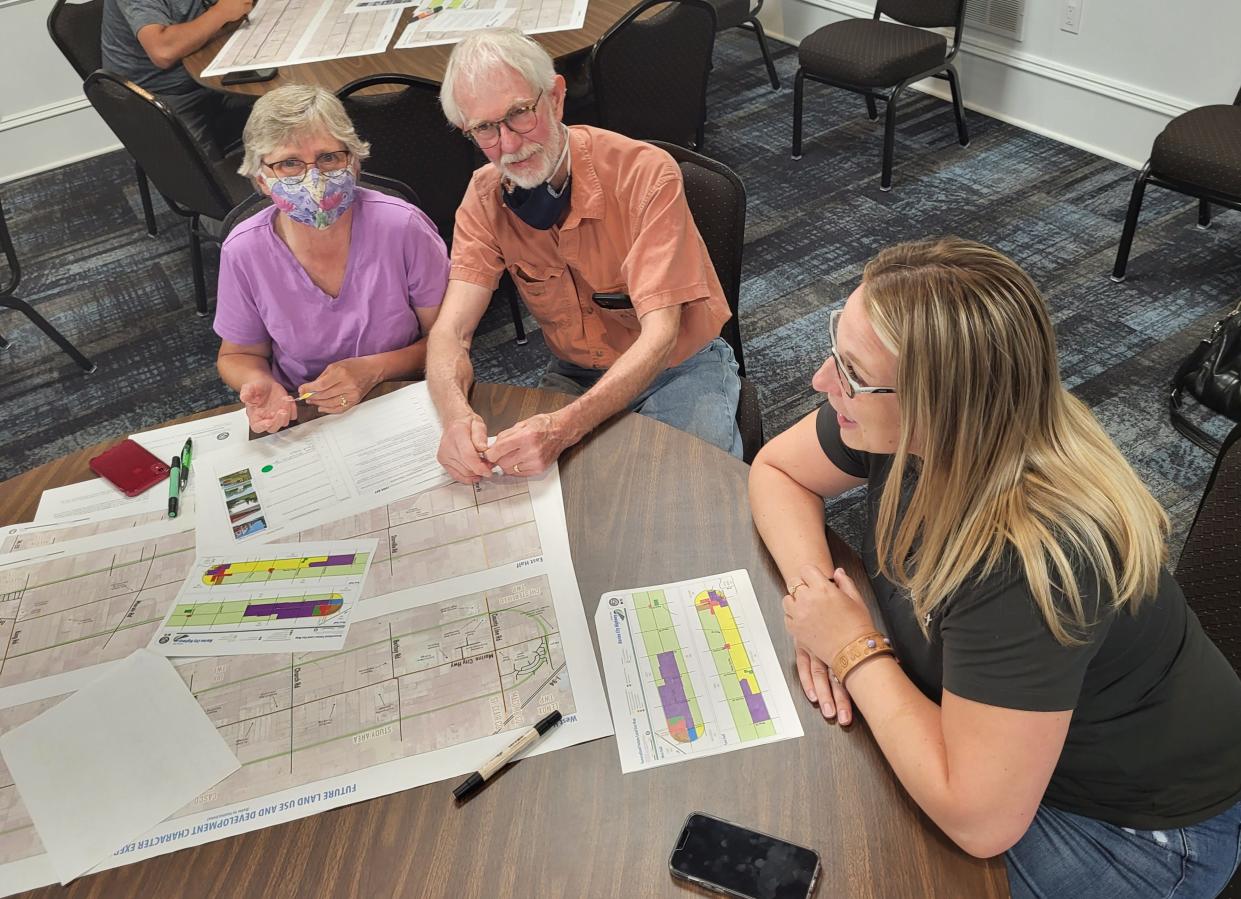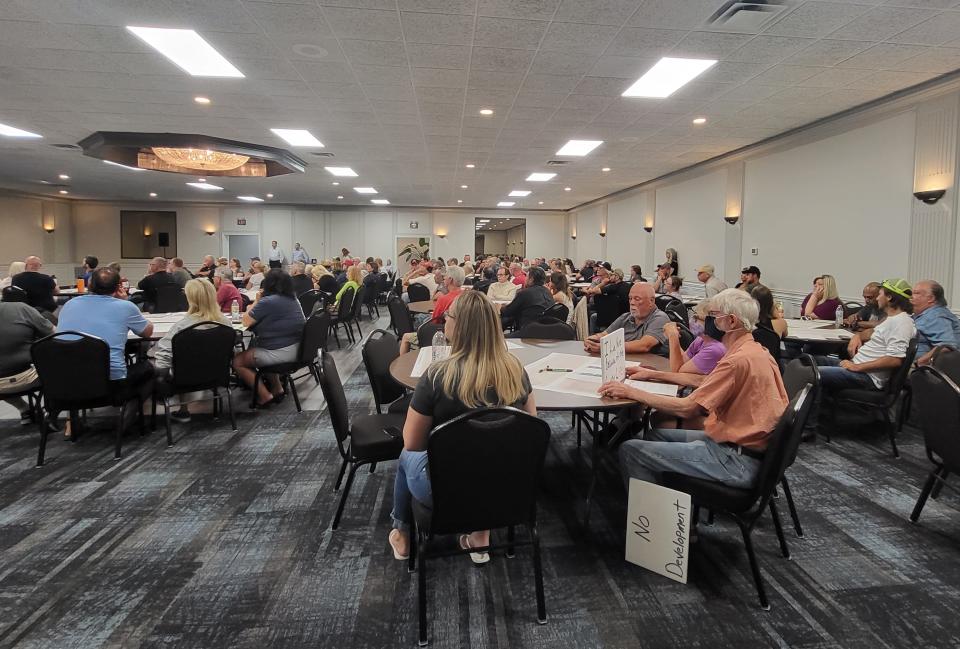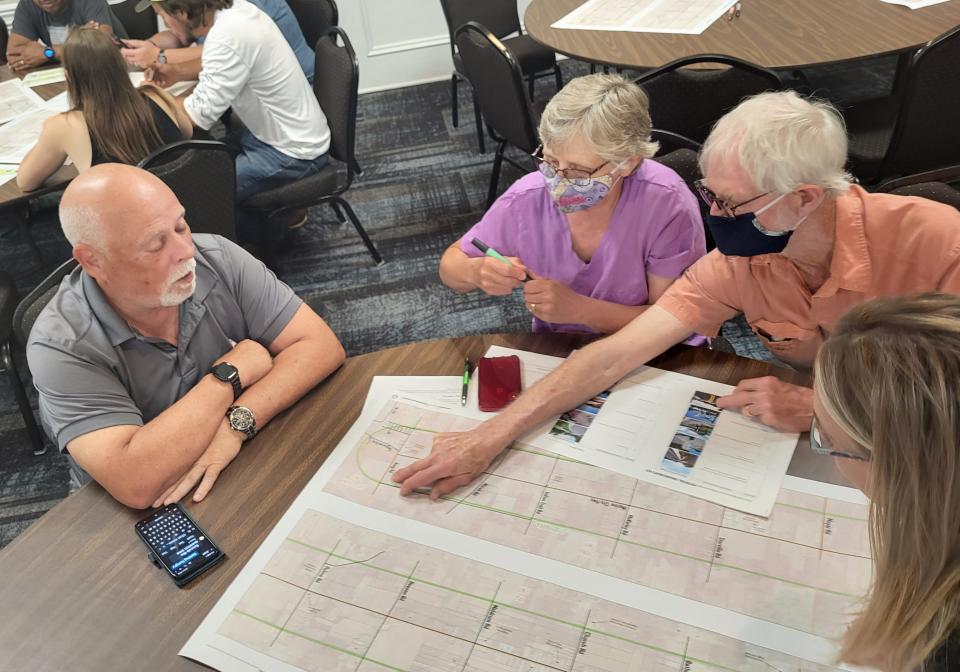Resident give feedback on Marine City Highway corridor plan

Several groups of area residents poured over maps of St. Clair County’s Marine City Highway corridor Wednesday night — round stickers and markers at hand.
And at one corner table, Stacy Bellis sat with three Cottrellville Township residents, weighing what kind of infrastructure was important for them along that 11-mile stretch of roadway when they reached their first of several common priorities.
What about non-motorized pathways for pedestrians, bike paths, and bike racks?
“I would love to be able to ride my bike without getting run over,” said Chris McCue, who lives near the eastern end of the corridor. “But I’m terrified getting from my place to the King Road and the bike path.”
“Because you can’t cross King, right?” said Bellis, a resident of Marine City and executive director of its area chamber of commerce. “… Even then, there’s no sidewalk for you. You have to be on the side of the road.”
Their discussion, as well as those of other tables Wednesday at the Harvest Event Center in Marine City, comes mid-way through the county’s ongoing effort to finalize a management plan for future development along the corridor, which stretches from King to the county line.
Adam Young, a spring project manager for Wade Trim, told the more than 140 people in attendance they hoped to finish the plan by the end of 2022.
The engagement at Wednesday’s input session, along with 1,300 responses from an online survey, he said, will go toward a cohesive set of priorities that may help guide local communities along the corridor in welcoming new development down the road.
“You care about the character of this corridor,” Young said. “Although we can’t stop growth, we can manage it.”
Those still interested in taking the survey can find it at www.surveymonkey.com/r/MarineCityHighway.

Officials to residents: We just want to be ready
Just over a year ago, St. Clair County officials began talks about using a large portion of the county’s $30.9 million share in COVID-19 stimulus funds through the American Rescue Plan to build new infrastructure along the corridor. They spoke particularly of adding water and sewer access to create more buildable sites and entice future investment. Wade Trim was hired to spearhead the management plan process last November.
Since then, the county’s Metropolitan Planning Commission has continued to promote information about the plan, process and how residents can give feedback.
“I don’t want a plan in a vacuum," Young said Wednesday.
County Board Chairman Jeff Bohm said they want to continue the momentum of other recent efforts, such as the one that helped bring a Magna International company to the former St. Clair Industrial Park. He wants Marine City Highway, or 26 Mile Road, to be ready.
“When I talk about ready, I’m talking about water, sewer, no wetlands,” Bohm said. “… We’re not there yet. And I want to emphasize, we’re in the very, very, very early stages.”
Dan Casey, CEO of the Economic Development Alliance of St. Clair County,
pointed to growth that's already in motion in communities like Ira and Casco townships along the corridor, where subdivisions are cropping up and industrial projects are in the works.
He also referenced the growth on the Macomb County side of 26 Mile, where there’s a newer Meijer, other retail, and medical facilities popping up. They're signs things are coming.
“They already did their own research and made their own decisions that that’s where they want to invest,” Casey said. “The growth will come, but it’s going to take a long time,” he said. “The question is … are you just going to let growth happen with no plan or are you going to put a plan together that says we’ll manage it?”
Consultants get down to detail, as residents weigh in
Young said St. Clair County’s existing 2045 master plan does have a rough vision in terms of what desired uses there could be for property along 26 Mile.
Currently, though it’s mostly rural. That and agricultural needs makeup 47% of the space half a mile north and south of the highway. Single-family residential makes up roughly 24% of the study area, while the rest is divided among multi-family and mobile homes, recreation, and small commercial spaces.
Wade Trim consultants have also looked at population access within 15- and 60-minute drives of the corridor with much of the residential growth arriving in northern Macomb County. And they touched on age trends with the median age on the rise.
The average daily vehicle count range, he said, is around 6,000 on the east end of the highway to 15,000 near the county line.
Wade Trim’s presentation to county residents can be found on the metro planning page at StClairCounty.org.

Within a half-hour on Wednesday, Bellis’ group — also including Nancy and Chet Kilanowski — had marked their top five infrastructure points with a sticker and marked up specific areas on the corridor map in marker.
There was broadband and potentially road-widening and roundabouts discussed in certain areas. They left out boulevards and others but wrote in environmental impacts.
“Trees. My daughter brought up a comment about trees,” Bellis said. “Because if they do this, they’re going to knock a ton down.”
Chet Kilanowski, who clasped a small protest sign that called for “no development” kept his environment interest broad, adding, “Any land that you develop, I don’t care what it is, that land is lost forever. . It’s gone. … There should be no new land development, period.”
McCue replied, “That’s not going to work.”
Elsewhere in the room, similar priorities had emerged once discussions ceased.
Marine City Manager Holly Tatman, who spoke for a table of other community officials, said they didn’t do much with infrastructure topics like buried utilities, focusing mostly on safety issues.
“Everybody agreed that especially at any intersections there needed to be widening of roads, turn lanes, increased lighting, (and) roundabouts throughout the corridor, slowing traffic and forcing attention to the road because they’re breaking up rather than a straight shot all the way down. The lighting, we did that on almost all of the major intersections because it is rural, it is dark, it is hard to see not only cars but the critters.”
Contact Jackie Smith at (810) 989-6270 or jssmith@gannett.com. Follow her on Twitter @Jackie20Smith.
This article originally appeared on Port Huron Times Herald: Resident input part of process for Marine City Highway corridor plan

